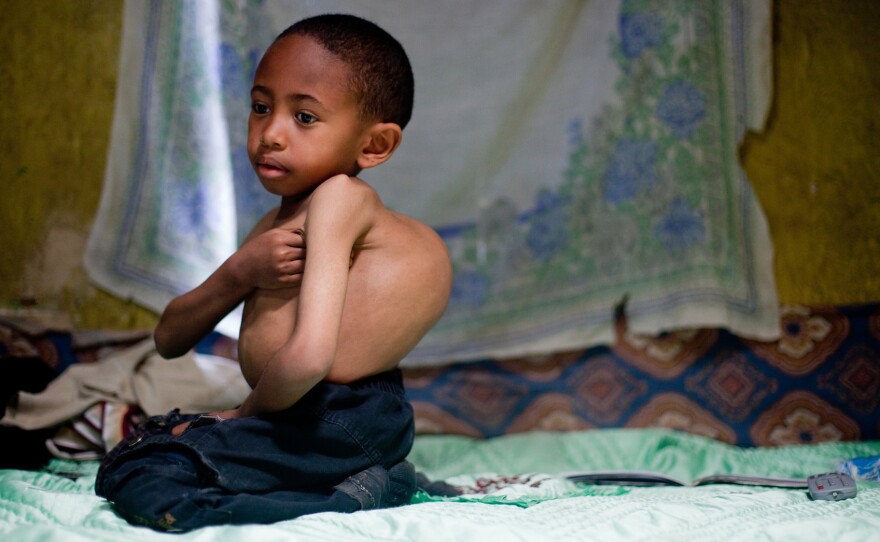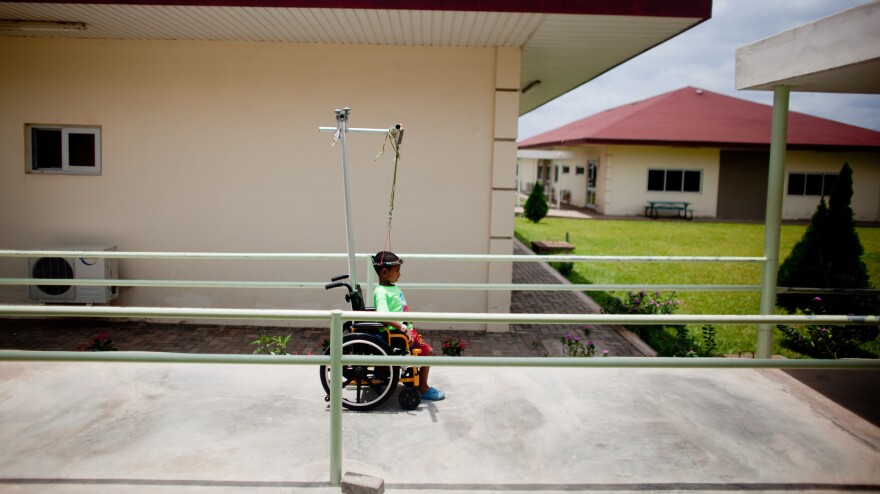One dewy morning back in May 2013, a dozen children gathered in an elementary school courtyard to play soccer in Addis Ababa. Seven-year-old Sisay Gudeta stood alone on the balcony above them.
Sisay poked his head through the arms of a rusty, blue guard rail, staring down at his classmates as they kicked an empty plastic bottle across the pavement. The kids rarely ask him to play, Sisay says. They are afraid to touch him, afraid of the bump on his back that stretches out his neatly pressed school sweater.
"He is such a beautiful child," Sisay's grandmother says. "I ask God what I did to do this to him."
For reasons unknown, thousands of children in Ethiopia suffer from congenital spine conditions so severe that humps grow from their backs. Their spines resemble flattened pancakes and roller-coaster tracks, says Dr. Rick Hodes, an American who runs the only spine clinic in Addis Ababa, a city of 3 million people.
Such extreme scoliosis cases are found in many poor countries. But Hodes thinks that lack of screening and access to basic medical care leaves Ethiopia with some of the worst spines in the world.
If not effectively treated, scoliosis can lead to permanent deformity, disc injuries and neurological damage. Here in the U.S., the National Institutes of Health recommends doctors use a brace to help straighten a child's back when the spine curves more than 25 to 30 degrees. When the curve reaches more than 45 degrees, surgery is often needed.
Yet thousands of Ethiopian children receive no medical treatment for their scoliosis. In villages, a traditional healer may try to flatten the child's back by pressing hot rocks to the skin. Others with twisted spines and humpbacks are ostracized or abandoned and left to die.
In Addis Ababa, Hodes examines more than 200 spine patients each year. The majority have curved protrusions on their backs greater than 100 degrees. Hodes says he once saw a patient with a 240-degree curve, "like a saxophone."
"We're sort of setting world records [for spine curvatures]," says Hodes, who leads the Ethiopian medical branch for the nonprofit American Jewish Joint Distribution Committee.
Without continued treatment to correct the 120-degree curve in Sisay's spine, doctors say he will have only the lung capacity of an 8-year-old. His limited breathing will be unable to support his growing body, and he will likely die, perhaps as early as age 14.
But despite his condition, Sisay sounds like a typically 7-year-old boy at his home when we visited him. His biggest worry, on that day, was keeping the TV antennae working. Otherwise how would he watch Tom And Jerry?
"I don't touch it," Sisay says of the TV. "If I touch it, it will break. And if it breaks, I will not be happy."
Surgeons in Ethiopia are ill-equipped to perform procedures as complicated as the one Sisay needs. But a doctor nearly 4,000 miles away in Ghana can do the $20,000 corrective surgery.
Twice a week, Hodes evaluates patients from Ethiopia to see if they're candidates for the surgery. Every three months, he sends about a dozen of them to Accra, Ghana, where Dr. Oheneba Boachie-Adjei examines and sometimes fixes their backs. Adjel, an orthopedic surgeon at Weill Cornell Medical College in New York City, leads the nonprofit Foundation of Orthopedics and Complex Spine, offering complex medical procedures to poor people across Africa.
"If you leave these kids alone, you won't see them as teenagers," Boachie-Adjei says of his patients.
Sisay is one of the lucky few.
In late 2013, Boachie-Adjei drilled four holes into Sisay's skull and affixed a metal halo to his head. The halo contraption stretches out Sisay's back so there's enough space for his spine once it's straightened.
During the month of December, Sisay grew about 2.5 inches to 3-foot-5.
Then in March, Boachie-Adjei sliced opened Sisay's back and inserted screws into many of Sisay's vertebrae. The surgeon also attached growing rods to Sisay's spine to help straighten and lengthen it.
Around the time Sisay hits puberty, he will likely undergo a final procedure to finish correcting the curvature. But for now, Sisay is healing at home in Ethiopia — and still worried that he'll catch the next episode of Tom And Jerry.
Faiz Siddiqui is a senior at the College of Journalism and Mass Communications at University of Nebraska-Lincoln. He and photographer, senior Andrew Dickinson, traveled with nine other students and three teachers to Ethiopia as part of an ongoing multimedia project on poverty.
Copyright 2014 NPR. To see more, visit http://www.npr.org/



















